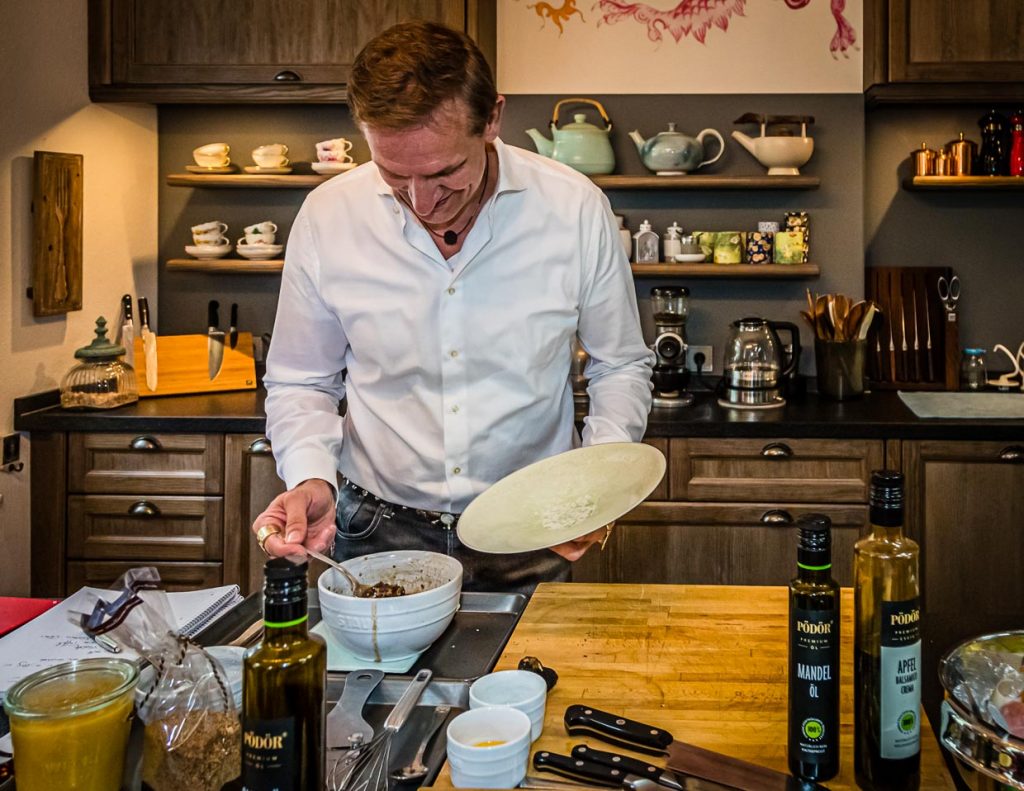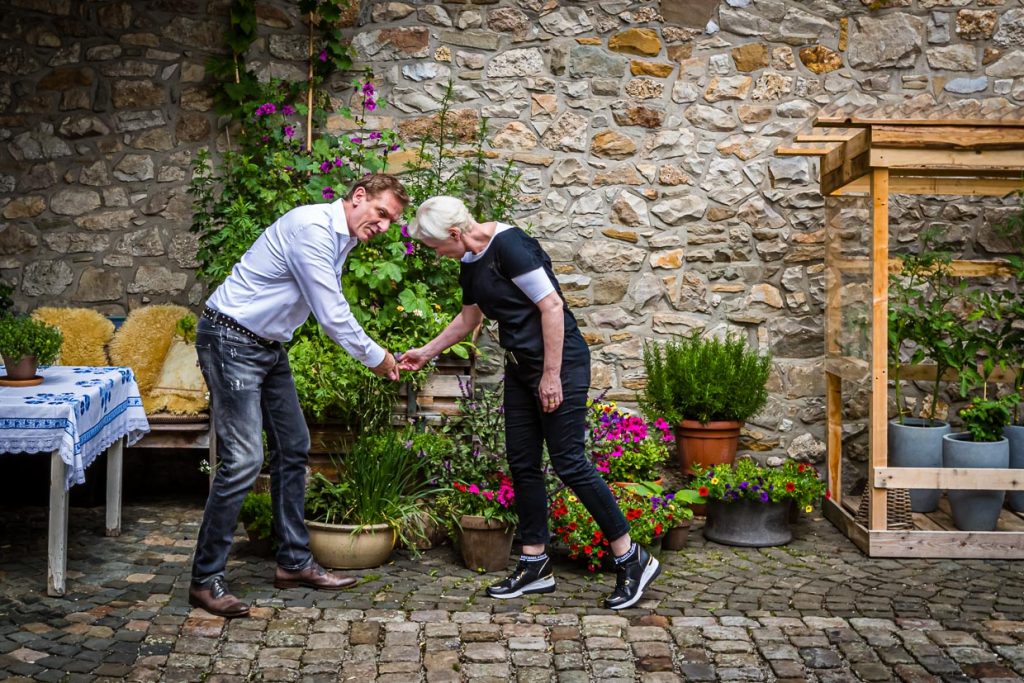A cookbook about oils and unadulterated flavor
Every year, around 2,000 new cookbooks are published in Germany. To stand out from this crowd, a new topic, an outstanding visual appearance, or a well-known cooking personality is required. Susanne Vössing’s new cookbook does all of these things equally well. The top chef has taken on the subject of cold-pressed oils. The result is The Cookbook – with probably the best oils in the world in cooperation with PÖDÖR Premium Oils and Vinegars. This book is not a salad book, as one might superficially conclude from the title. It is an inspiring reference book that offers a total of 108 recipes on 224 pages and shows what you can prepare with the various oils in everyday life.

The cookbook was the result of creative interaction between the couple Su and Bui Vössing. They are self-publishing it. It is already clear from this that the topic of oils is a matter close to the heart for the top chef. Photographer Bui Vössing puts all his experience and enthusiasm for detail into the visual language. It is unspent and unusual. The styling matches the unadulterated flavors of the pure varietal oils. Bui Vössing contrasts natural backgrounds such as flamed wood, leather, fur or chalkboard with the finest tableware. The photographs serve as a reference for the reader, as the dishes are served warm by Su Vössing and photographed without the aid of artificial additives. We visited the couple in their studio in the old town of Stolberg near Aachen and learned about the effort the cook and photographer put into producing each page of the book.

Recipe development begins in the mind
“I am a very quiet person,” Su Vössing says about herself. For recipe development, the cook needs quiet. Then she stands by the window or sits by the fireplace and thinks up a dish. “I think, write notes and decide a lot intuitively.” For the recipe, it’s a matter of then recording the spontaneous decisions in precise notes. Her ingredients are listed by exact weight. There are no imprecise units like teaspoons or tablespoons. This, too, is a guarantee of success when re-cooking.

In search of unadulterated flavor
“Our food,” says Su Vössing, “doesn’t get better by cooking, so it all depends on the starting product and its quality.” She works with 20 different cold-pressed oils from Pödör Premium Oils for this cookbook. The Hungarian-Austrian company has been developing and producing premium oils and vinegars since its founding in 2011. The Pödör pressmaster is a co-founder of the company and is already pressing cold-pressed oils in the fourth generation. Thus, the company can draw on more than 100 years of experience in the production of cold-pressed, high-quality oils and develop products that meet the zeitgeist of demanding consumers. Only thoroughly purified and 100% natural raw materials of the highest quality are used by expert master pressmen in manual production. The products are bottled according to the strictest quality criteria in order to preserve the healthy and unsaturated fatty acids.

Su Vössing uses classics such as walnut oil or linseed oil, but also unknown oils such as apricot kernel oil, cress seed oil or pistachio oil. The result is a cookbook that has never been seen before in this form. Outstanding and large-format photographs awaken the impulse to want to recreate the dish. Helpful information, such as the oil register, takes away the shyness of dealing with many an unfamiliar type of oil, and the importance of essential fatty acids in our diet is discussed right at the beginning. The cookbook serves the complete menu sequence from soup and appetizer to dessert and offers a wealth of ideas for spreads, pestos, dressings and breakfast. Each recipe can be cooked at any time of year. The reader with an appetite for cooking will encounter a whole new field of unadulterated flavors that bring new culinary life to our everyday meals. But how does such a comprehensive reference and recipe work come into being?

Recipe texts are uncharming
Before a single dish is even created, Su and Bui Vössing have already agreed on the layout of the book. The basic color scheme, what typography, block or flat type? Only then does the development and production of the recipes begin. “We work into the finished book body and create a coherent and balanced unit, just like a good meal” says Bui Vössing. The photographer considers the texts of a cookbook to be highly uncharming. “Objectively, recipe texts are lists and commands “do this, take that, now do this…”. But the imagery juxtaposed with the texts is so evocative and engaging that it immediately creates an impulse in the reader to want to recreate the dish.

The light model – fine porcelain and cardboard
After an initial description of the dish, Bui Vössing selects a plate and takes it into the kitchen for closer coordination. Do the ingredients, some of which are already prepared in the pots, match the porcelain in terms of color and texture? Working with the light model and a piece of cardboard in place of the food, he tweaks the setting. Which background? Scarfed wood? Scarred leather or the black fur of an old Le Corbusier couch?

Which silverware, napkin, a saucer yes or no. Decoration in allusion to the dish or flowers from your own garden? All accessories must be personalities, genuine. Quickly more than an hour has passed before the shooting enters the proverbial hot phase.

Foodstyling – à la minute under the lens
The dishes are arranged by Su Vössing warm and, if you will, à la minute. While she makes final decorations with tweezers, Bui Vössing checks the overall picture on the monitor. “The more precisely I work, the finer the transition from sharpness to blur,” explains Bui Vössing.

Reflection in silverware is a big issue. Silver has the highest reflectivity. It is in the darkest place here in this set, but still has a high presence. All dishes are basically photographed without the aid of artificial additives to create reliable references for the reader with a desire to cook.

The cookbook at a glance
- 224 pages, 108 recipes, published by Su Vössing GmbH, price 39 euros
- complete menu plus dips, dressings, pestos and breakfast recipes
- New: recipe development adapted to the sensitivity of cold-pressed oils
- Oil register with background information and possible uses for 20 edible oils from PÖDÖR Premium Oils and Vinegars
- Large format, noble and natural food photography by Burkhard Vössing
- Exceptional imagery furnished with pieces from the French porcelain manufactories Jaune de Chrome and JL Coquet from Limoges
- Fine silverware contributed by the dining culture specialist Franzen from Düsseldorf
- The photographs serve as a reference for readers, as the dishes are served warm by Su Vössing and photographed without the aid of artificial additives by Bui Vössing
- Sources of supply: PÖDÖR Premium Oils and Vinegars on the web store and through participating retailers, as well as on the QVC channel.
About Su and Bui Vössing
Su Vössing completed her training as a cook in Warburg. In her early 20s, she moved to Paris and worked with top chefs such as Jean-Michel Bouvier and Alain Senderens. As head chef at Le Maron in Bonn, she became Germany’s youngest female chef to receive a Michelin star at the age of 27. Further stations were La Société in Cologne and Café Europe in Key West / Florida. From 1997 to 2005, Su Vössing appeared as a TV chef in the cooking duel on Vox. She can be seen regularly on the sales channel QVC as a product expert. In 2009, together with her husband Bui Vössing, she founded Su Vössing GmbH, focusing on cookbooks, cooking school, food photography and events. Since 2013, Su and Bui Vössing have been living and working in the old town of Stolberg near Aachen.

